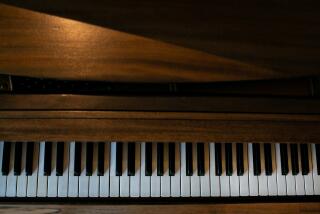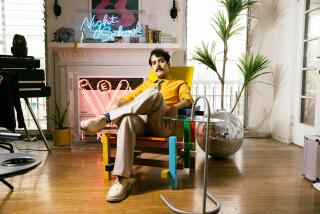Andres Segovia, Virtuoso of Solo Guitar, Dies at 94
Andres Segovia, Marquis of Salobrena by royal decree and sovereign of the guitar by universal acclaim, has died at his home in Madrid, it was reported Wednesday.
The ultimate virtuoso of his instrument was 94 when he died. He had been hospitalized with heart problems in New York last April during what proved to be his final tour.
Dr. Angel Castillo, a family physician, said Segovia’s wife was so overcome with grief that she asked that the death of her husband late Tuesday afternoon not be announced until Wednesday. Castillo said the legendary guitarist died peacefully while watching television with her.
His passing ended an 80-year, pervasively accepted endeavor to make the guitar more than just a simple instrument suitable only for accompaniment. For at his death millions around the world had heard his adaptations of Bach, Haydn, Mozart and Scarlatti, and thousands yet to come would try to follow in his footsteps as classical artists.
Segovia, the querulous, inquisitive boy who had taught himself when no one else would take his musical quest seriously, had become Segovia, the cosmic artist who had the title of marquis created for him in 1981 by a grateful King Juan Carlos of Spain.
He and painter Pablo Picasso were considered Spain’s most treasured exports of this century.
And, like Picasso, Segovia molded the techniques of the past to the realities of the present. In Segovia’s case, it was a 12th-Century, six-stringed device descended from the ancient lute from which he drew drama and melody in forms never heard before and seldom exceeded since.
He was, said Beatle George Harrison, “the father of us all.” For before Harrison and the other moderns could commercialize the instrument, there had to be the conceptualization.
And that was realized by Andres Segovia.
Since 1909, when he was 15 and made his professional debut in Granada, he had performed on stark stages normally containing only a piano bench, a footstool and a guitar, which the artist always referred to as “female” because of its shape.
He would wrap his fat, stubby fingers around its neck and pluck from it nuances once considered far beyond its limitations. His instrument, he frequently said, was “not voluminous, but luminous.”
Despite the enormities of whatever concert hall was involved, critiques of Segovia almost always involved the word “intimacy.” His performances, said the musicologists of the world, were “sophisticated,” yet they also were “vibrant” and acclaimed as lessons of rhythm, style and inflection.
His left hand was wrapped around the guitar’s neck in grotesque positions that would have pained the untrained, all the while caressing the strings with a scholar’s fingers. Yet he could also strum with a wild abandon when appropriate.
‘Innate Sensitivity’
“Everyone says that Andres Segovia tamed the guitar, made it respectable, even invented it,” Martin Bernheimer, The Times music critic, said Wednesday. “For most practical purposes, it is true. By stressing his historical contributions, however, we may overlook the innate sensitivity that made his art compelling in later years, even when his fingers could no longer do everything his brain might have dictated. He was, and remained, a musician in the loftiest sense.” This and the other accolades were but a distant glint in the future when he was a boy.
“When I was young I wanted to play the guitar,” he wrote in one of two autobiographies. “But I was told it wasn’t respectable. My father broke three guitars to stop me from practicing.”
Parental outbursts were not enough. The practicing and the studying continued. Both were done in isolation, for there was only one guitarist in the mining town of Lunares, where Segovia grew up, and that man played flamenco accompaniment only. Segovia, the musical iconoclast, wanted to speak for, not in tandem with, the guitar.
Segovia mollified his lawyer father slightly by taking up violin and cello but found that the teaching bored him, and he soon prevailed on his embarrassed family to let him concentrate on his chosen instrument--the one he had continued to practice clandestinely.
Tells of Preparations
There is no known record of his Granada debut or of his performance in Madrid in 1912, three years later. But Segovia has discussed his preparations, if not his performing skills, during that period.
He believed that many of Bach’s solo pieces had been written originally for the lute but had been transcribed for other instruments. Segovia reasoned that they could also be adapted for guitar and, once transcribed, would grow in strength because of the guitar’s steadier pitch and firmer strings than those of the lute. If it was a theory that drew cries of disbelief from musicologists, it nonetheless served the young Segovia’s needs and his early, infrequent appearances grew in number and popularity.
In 1923, he traveled to London, where the critic for the Times came to hear him with something less than enthusiasm for what he pronounced in advance as “this inferior instrument.” Later, however, he wrote, “we remained to hear the last possible note, for it was the most delightful surprise of the season.”
The next year, at the insistence of Pablo Casals, the cellist, Segovia performed in Paris, where his audiences included composers Manuel de Falla and Paul Dukas. The critics offered effusive praise and De Falla’s music became new grist for Segovia’s guitar.
De Falla had been widening the Spanish idiom, protecting its rhythmic heritage while expanding its limited musical language. Such De Falla compositions as his “Homage to Debussy” and “Studies No. 1 and 8” were adapted to guitar and added to the Segovia repertoire that by now included the lute works of Sylvius Weiss and some obscure songs written originally for the Spanish vihuela, another stringed instrument.
Segovia’s fellow musicians continued at this point in his career to be his prime supporters and often composed most of his audiences as he concertized throughout Europe. But by 1928 his performances of the Baroque adaptations of Bach and Scarlatti, coupled with the contemporary offerings of De Falla and Mario Castelnuovo-Tedesco had increased his appeal so that an American concert was seen as financially viable.
It came after violinist Fritz Kreisler heard him in Europe, and it took place at Town Hall in New York in 1928. Critic Olin Downes of the New York Times found the 34-year-old guitarist far more than a curiosity:
“He belongs to the very small group of musicians who by transcendent powers of execution and imagination create an art of their own that sometimes seems to transform the very nature of their medium.”
Segovia the man had achieved the critical acceptance never granted Segovia the boy.
The Town Hall concert was followed by five others in New York City and 25 in other cities. Most were sold out. Segovia’s romance with international audiences had begun.
The timing was fortuitous, for Segovia was now without a home. By 1936 the Spanish Civil War had forced him to leave his birthplace.
“The anarchists, the communists, the terrorists were tearing up everything,” he told the Associated Press years later. “I went to Italy and then settled in Montevideo (Uruguay).”
He spent most of the early years of World War II there, continuing to perform in other countries as travel restrictions permitted and returned to the United States in 1943 for a national tour, this time not as a young artist involved with a suspect instrument but under the aegis of master impresario Sol Hurok.
His initial Los Angeles performance had come seven years earlier in 1936, and despite his successes in the East, local critics, accustomed to Latin-American balladeers rather than serious soloists, were hesitant to lend much enthusiasm to his appearance.
The Los Angeles Times, in a footnote to another review, announced only that “Segovia plays here tomorrow night and Harpo Marx has taken 12 seats.”
The artist proved more hospitable than the critic and he continued to perform annually in Southern California. His final appearance was in April at the Ambassador Auditorium.
Postwar years brought renewed interest in the guitar and not just on a classical level. Charlie Christian, an American black, and Django Reinhardt, a Gypsy, had made of it a serious jazz instrument in the 1930s and it became the mainstay of an emerging form of blues and rhythm soon to be known as rock ‘n’ roll.
This guitar sound, however, was not the “female” Segovia had come to love as a boy but an amplified “abomination.”
“Whoever heard of an electric violin, electric cello or for that matter an electric singer,” he commented to one interviewer.
If Beatle Harrison looked to him as a “father,” stylist Segovia was less charitable to the Liverpool group.
“They are very nice young men, no doubt, but their music is horrible.”
He passed 50 and moved into his 60s still practicing five hours a day. Tall and courtly in manner, he would walk on stage wearing a somber coat and flowing tie. He took an apartment in Manhattan and filled it with Spanish antiques. He became a philosopher as well as a performer and in 1961 likened his playing to a construction project.
“When one puts up a building one makes an elaborate scaffold to get everything into its proper place. But when one takes the scaffold down, the building must stand by itself with no trace of the means by which it was erected. That is how a musician should work.”
He both accepted degrees from universities and conducted their classes.
In 1981, Lawrence Christon, a critic for the Los Angeles Times and a guitarist, took Segovia’s master class at USC and found that “the largest lesson was his poet’s gift for bringing us back to our purest senses. He taught us throughout that one cannot understand music or play it well without listening first.”
Segovia’s health remained exceptional into his 90s, with only an eye operation for a detached retina in 1968 interrupting his playing schedule and the heart problem that brought an end to his most recent tour in April.
Had Son at Age of 77
In 1961 he had married Emilia Corral, a former pupil. Nine years later, at the age of 77, he became the father of a son, Carlos Andres. He had another son, Andres, now 65, from a previous marriage.
He made hundreds of records, ranging from “Bach for His Master’s Voice” on a 10-inch, 78-rpm record in the 1920s to the contemporary songs and suites of Granados, Ponce and Albeniz.
His schedule in those last years would have tired one of the younger rock guitarists he disdained. Segovia required only 4 1/2 hours sleep to refresh himself. He called himself a “profoundly religious man without dogma. A Catholic but a distracted Catholic.”
His long life he facetiously attributed to piety, telling an interviewer in 1981 that “my prayer to the Lord is I have been a great sinner. I do not deserve heaven. Let me stay here.”
Self-effacing for an artist, he said his talent derived from divine intervention.
“I received from heaven a gift for music and could not do anything but music. The vocation was compulsory.”
And eminently successful.
More to Read
The biggest entertainment stories
Get our big stories about Hollywood, film, television, music, arts, culture and more right in your inbox as soon as they publish.
You may occasionally receive promotional content from the Los Angeles Times.










